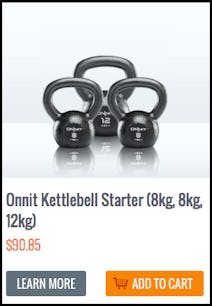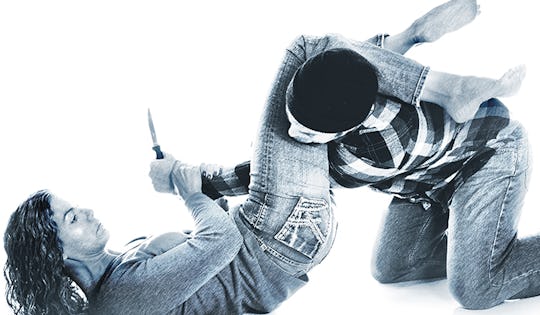Desperate times call for desperate measures. There are times when the human body is called upon to display physical fitness, mental toughness, and the ability to problem solve in the face of danger.
Sometimes while feeling this feeling, your body has what is known as signal anxiety; you sense something is wrong and your mind sends signals to the central nervous system to prepare to defend itself in an empty parking lot after hours.
You’re cut off while driving and you swerve, miss the car only to look down at your trembling hands, breathing frantically while your heart races. You perceive you are in danger and prepare to act, or you are in danger and act with what you’ve done as long as you can remember.
History of Hand-to-Hand Combat![Onnit Kettlebell Starter Kit]()
In 1941, desperate times also called for desperate measures. Rex Applegate was a second lieutenant recruited to create a new school of fighting for what was then called the Office of Strategic Services. Developing “The School for Spies and Assassins,” Applegate learned all he could from William E. Fairburn, a British master of hand to hand combat.
Applegate, with his own knowledge gained from others, developed styles of knife fighting, shooting, and close quarters combat. He became the father of modern military combatives for the US Army and his methods are still taught today to soldiers around the world. Combatives: the art of fighting in a desperate situation when your back is against a wall.
This history reads slightly different from traditional martial arts, like jiu-jitsu, judo, or karate. Created using these disciplines, combatives were still considered martial arts. The thought process of martial arts is different, utilizing belts and competitions to advance in skill, while combatives focused on quickly learned intuitive skill, experience, and the competition being the battlefield, not the ring.
Developing Hand-to-Hand Combat Techniques
I am often asked, “What’s the difference between combatives and martial arts?” The difference is within its base teaching, as one does not have years to learn through belts to defend themselves. Those years are for mastery while now is about survival. A student may only have one class, one seminar, a few days in basic training or police academy.
While martial arts have many focuses, such short-term learning has but one focus: violent action protecting one’s life. But, in many ways, this does not lead to long-term learning, as devastation is the design of combative methods, to cause as much injury to a person who attacks another in the real world (using methods not legal in competition).
For Pramek, our history going back to the scientific systems of Russia (not to be confused with what is commonly taught as ’Systema’) to modern combatives and many influences in between, we view combat through lenses unlike other systems. We see science as a study tool to last beyond the first learning stages of defense. To study the biomechanics, mechanics, physics, psychology, neurology, and strategy to create a long-term study for the student.
The fitness community is especially suited for the study of combatives. Fitness, like martial arts, is a lifelong study. We spend inordinate amounts of time on our mechanics, physics, the neurology of training. We look at diet, how the body responds to food and exercise, what makes the body weak or strong, injured or sore, our range of motion, our energy levels, our coordination.
The explosive power of a hip thrust or clean and jerk translate specifically into the explosive power needed for self-defense in combatives. The range of motion needed to generate power or ease the pressure of joint locks. The mental toughness of fitness training and competition, from kettlebells in the garage to bodyweight workouts. Perfect training for the needs of combatives, never giving up under any circumstance.
The 80/20 Rule
Applegate once wrote of his 80/20 rule – that 20% of fighting is technique, but 80% is the willingness to get home no matter what. You can teach technique but you can’t teach heart. You can’t teach the will to survive, you can only train the mind to reach beyond previous limits, combining this with what psychology tells us is the mind’s ego and its willingness to protect itself beyond all other tasks.
“20% of fighting is technique, but 80% is the willingness
to get home no matter what.”
If you are limited in time throughout the day as I am, the question becomes what of Applegate’s 20%? The great philosopher Theophrastus once stated time is the most valuable commodity a man can spend. We can’t get time back, there is no refund. The most significant threat to our time is the threat of being killed or injured in an attack.
How do we maximize the time for the 20%?
Do we make the most of our fitness ability to optimize it?
Do we study the sciences that govern human interaction and violence to be faster with it?
Do we understand the difference in kinematics between equilibrium and balance, or rely on chance for someone to fall down?
Do we punch or do we open hand strike, knowing the damage each causes?
Do we learn 10 techniques for one situation, or 1 technique for 10 situations?
Why is Fitness Beneficial to Combatives?
A ring or competition cannot duplicate the stress of a combative situation. Recently we ran a test in a firearms simulations course for Sage Dynamics, a company I teach for. We found that with minimal physical exertion the heart rates of students were spiking at 200 Beats Per Minute, simply because of the stress of combat.
This is something that only a fear of losing one’s life can cause. Those in great physical shape have the utmost advantage here as they have conditioned themselves to perform tasks at high heart rates. They can control their breathing and in turn their sympathetic nervous system allows them more access to make decisions from the large amounts of oxygen that is delivered to the brain under SNS activation.
By utilizing these high levels of physical fitness (development is crucial to maintaining health) and combining it with the right combative training, we succeed in our long-term health and short-term survival. The great enemies have a fight in themselves. I learned this doing close protection details when I nearly lost my life in an elevator protecting a client one night.
Fighting against a bigger and stronger attacker, I realized there is a balance between the benefits of fitness, combatives, martial art, and science. It’s making the most of the 20%, because the 80% is all we have in the most desperate times in which created combatives.
The Benefits of Fitness in Hand-to-Hand Combat
- Allows control over breathing during stress.
- Enhanced performance with a high heart rate.
- More oxygen for the sympathetic nervous system to operate with.
- Enhanced mental toughness.
- Increased range of motion to ease the pressure of joint locks.
- Increased explosive power for self-defense movements.



)





